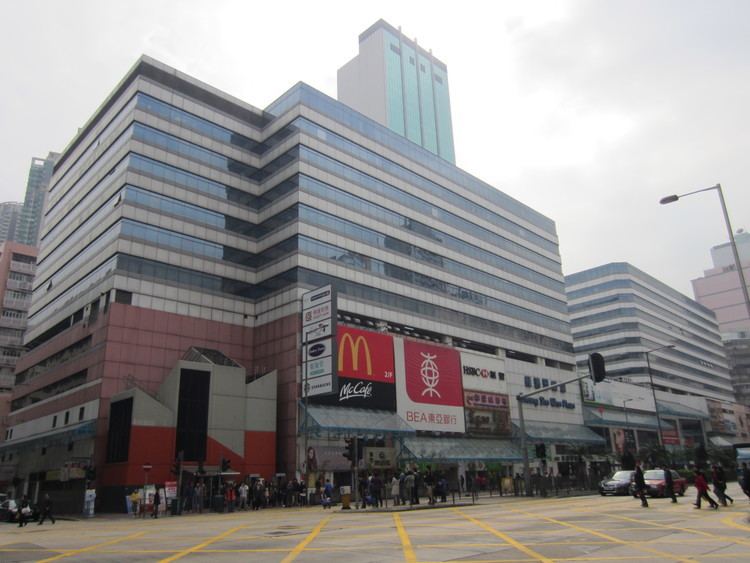 | ||
Restaurants Greater China Club, Little Break Coffee & Kitchen, Hover City Chiu Chow Restaurant, 鵜舞, Kwan Kee Bamboo Noodle | ||
Cheung Sha Wan (Chinese: 長沙灣) is an area between Lai Chi Kok and Sham Shui Po in New Kowloon, Hong Kong. It is mainly residential to the north and south, with an industrial area in between. Administratively it is part of Sham Shui Po District which includes Lai Chi Kok as well.
Contents
- Map of Cheung Sha Wan Hong Kong
- History
- Economy
- Private housing estates
- Public housing estates
- MTR stations
- Bus routes
- Cheung Sha Wan Bus Terminus
- Kom Tsun Street bus terminus
- Minibus routes
- References
Map of Cheung Sha Wan, Hong Kong
History
As its Chinese name suggests, it was formerly a bay with a long beach. It spans roughly from today's Butterfly Valley Road at the west to Yen Chow Street at the east. The beach was a gathering place for many Tanka fishermen before its development. The original shoreline approximates the present Castle Peak Road and Un Chau Street. Inland, villages of Om Yam, Ma Lung Hang, Pak Shu Lung, So Uk, Li Uk, Wong Uk and others sparsely occupied the whole bay of Cheung Sha Wan. Rivers from Beacon Hill, Crow's Nest and Piper's Hill formed a long plain behind the beach. Farmlands filled between villages. A larger river ran in Butterfly Valley separating Chueung Sha Wan and Lai Chi Kok. Sandbar was founded at its estuary.
The Lei Cheng Uk Han Tomb is located in Cheung Sha Wan, and dates from AD 25 - 220. It is the oldest known structure in Hong Kong, and demonstrates that early Chinese civilization had spread to Hong Kong by 2,000 years ago.
Before World War I, two ends, Lai Chi Kok and Sham Shui Po, of Cheung Sha Wan had been reclaimed. The former was for military use and the later emerged as a new town north of Tai Kok Tsui.
In April 2006, a total of 580 unused shells from the Japanese occupation of Hong Kong were found buried at Tonkin Street in Cheung Sha Wan. The residents were temporarily evacuated and the shells were detonated safely.
The bay of Cheung Sha Wan was reclaimed in several phases in the twentieth century. The last reclamation in 1990s extended the area close to Stonecutters Island. The shipbuilding and repair industries on the old shore were moved to near the island and the sites were replaced by some private housing estates constructed in the early 2000s.
Economy
Cheung Sha Wan was a manufacturing centre after the war, with a number of light industries, especially textile and clothing. After the PRC implemented its open door policy in the 1980s, many factories relocated to the mainland, vacating the area's industrial buildings (some of which have since been converted into offices and warehouses). There are several wholesale markets in Cheung Sha Wan. They include Cheung San Wan Temporary Wholesale Poultry Market, Cheung Sha Wan Vegetable Wholesale Market and many wholesale clothes markets. The Vegetable Marketing Organisation's Premium Vegetable Packaging Centre also locates in central Cheung Sha Wan.
Private housing estates
Several of the private housing estates were built on a former site of a shipyard which was relocated owing to the commencement of the West Kowloon Reclamation, or reclaimed land adjacent to it.
Public housing estates
A new public housing estate named Hoi Lai Estate (formerly named Hoi Lai Court before the government turned it into a public housing estate) is located in the area and had the most expensive rental fees within the Sham Shui Po District.
MTR stations
The area is served by two stations on MTR Tsuen Wan Line:
Lai Chi Kok Station is actually located not in Lai Chi Kok, but in Cheung Sha Wan. The fact that references to Cheung Sha Wan can be found on many buildings and amenities near Lai Chi Kok Station continues to be a source of confusion for many.
Bus routes
These bus routes terminate in Cheung Sha Wan, but on Cheung Sha Wan Road, Lai Chi Kok Road and Castle Peak Road there are many more routes that are available.
To So Uk Estate:
Cheung Sha Wan Bus Terminus
To Chuk Yuen Estate:
To Tsz Wan Shan North
To Allway Gardens, Tsuen Wan
To Tai Wo
To Lee On Estate, Ma On Shan (via Lion Rock Tunnel):
Kom Tsun Street bus terminus
To Sha Tin Wai (via Lion Rock Tunnel):
Minibus routes
To Caritas Medical Centre:
To Wonderland Villas:
To Stonecutters Island:
To Wonderland Villas:
